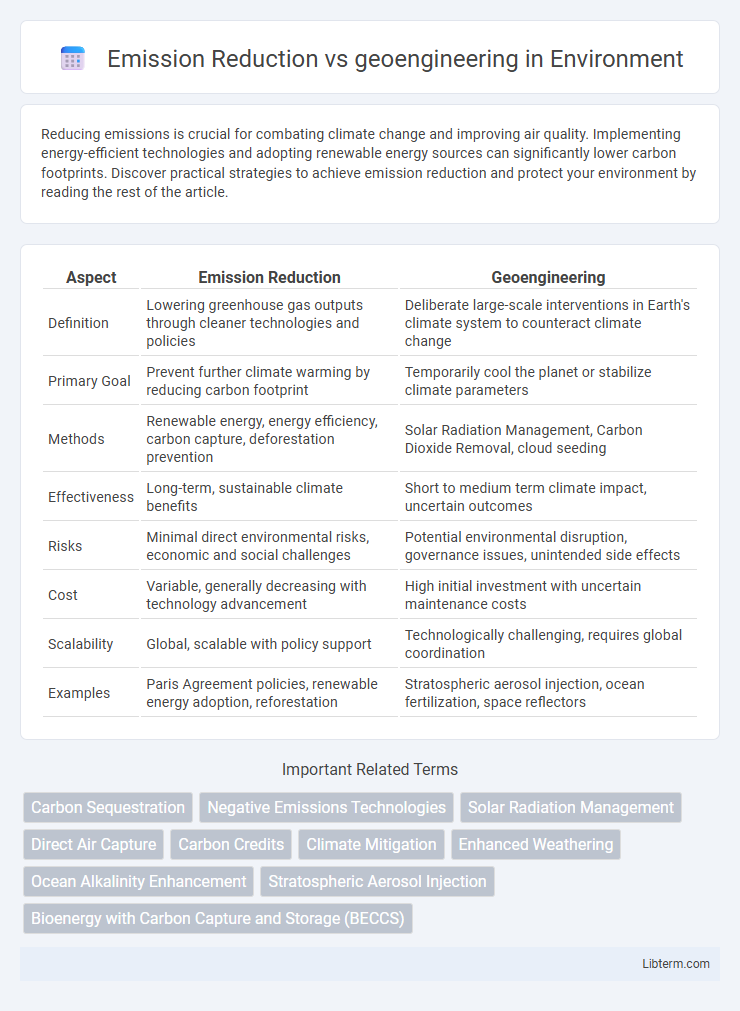Reducing emissions is crucial for combating climate change and improving air quality. Implementing energy-efficient technologies and adopting renewable energy sources can significantly lower carbon footprints. Discover practical strategies to achieve emission reduction and protect your environment by reading the rest of the article.
Table of Comparison
| Aspect | Emission Reduction | Geoengineering |
|---|---|---|
| Definition | Lowering greenhouse gas outputs through cleaner technologies and policies | Deliberate large-scale interventions in Earth's climate system to counteract climate change |
| Primary Goal | Prevent further climate warming by reducing carbon footprint | Temporarily cool the planet or stabilize climate parameters |
| Methods | Renewable energy, energy efficiency, carbon capture, deforestation prevention | Solar Radiation Management, Carbon Dioxide Removal, cloud seeding |
| Effectiveness | Long-term, sustainable climate benefits | Short to medium term climate impact, uncertain outcomes |
| Risks | Minimal direct environmental risks, economic and social challenges | Potential environmental disruption, governance issues, unintended side effects |
| Cost | Variable, generally decreasing with technology advancement | High initial investment with uncertain maintenance costs |
| Scalability | Global, scalable with policy support | Technologically challenging, requires global coordination |
| Examples | Paris Agreement policies, renewable energy adoption, reforestation | Stratospheric aerosol injection, ocean fertilization, space reflectors |
Understanding Emission Reduction and Geoengineering
Emission reduction involves minimizing greenhouse gas emissions through renewable energy adoption, energy efficiency, and sustainable transportation to tackle climate change at its source. Geoengineering encompasses large-scale technological interventions like solar radiation management and carbon dioxide removal to deliberate alteration of Earth's climate systems. Understanding the strengths and limitations of emission reduction and geoengineering is essential for developing comprehensive climate mitigation strategies.
Key Differences Between Emission Reduction and Geoengineering
Emission reduction targets the root cause of climate change by lowering greenhouse gas emissions through renewable energy adoption and energy efficiency improvements, while geoengineering involves large-scale interventions like solar radiation management to alter the Earth's climate system directly. Emission reduction offers long-term sustainability by addressing carbon sources, whereas geoengineering provides temporary climate modification with potential unknown environmental risks. The key difference lies in emission reduction's preventive approach versus geoengineering's corrective strategy to climate change impacts.
Climate Change: The Need for Immediate Action
Emission reduction targets, such as cutting global carbon dioxide emissions by 45% from 2010 levels by 2030, remain critical to limiting global temperature rise to 1.5degC. Geoengineering techniques like solar radiation management offer potential but carry significant risks and uncertainties, making them insufficient as standalone solutions. Immediate and large-scale emission cuts combined with sustainable policies are essential for effective climate change mitigation.
Technologies and Strategies in Emission Reduction
Emission reduction technologies primarily focus on renewable energy sources such as solar, wind, and hydropower, which decrease greenhouse gas emissions by replacing fossil fuel-based power generation. Strategies also include carbon capture and storage (CCS), enhancing energy efficiency in industries and transportation, and promoting sustainable agriculture to mitigate methane and nitrous oxide emissions. These approaches directly target the root causes of climate change by lowering atmospheric CO2 levels rather than manipulating climate systems like geoengineering.
Types of Geoengineering Approaches
Geoengineering approaches to climate change primarily include solar radiation management (SRM) and carbon dioxide removal (CDR). SRM techniques, such as stratospheric aerosol injection and marine cloud brightening, aim to reflect sunlight to reduce global temperatures temporarily. CDR methods, including afforestation, bioenergy with carbon capture and storage (BECCS), and direct air capture, focus on removing CO2 from the atmosphere to achieve long-term emission reductions.
Environmental Impact: Emission Reduction vs Geoengineering
Emission reduction directly addresses the root cause of climate change by lowering greenhouse gas concentrations, resulting in long-term environmental benefits such as improved air quality and ecosystem health. Geoengineering techniques, including solar radiation management and carbon dioxide removal, offer rapid climate intervention but carry uncertain risks like ocean acidification, disruption of weather patterns, and biodiversity loss. Comprehensive climate strategies increasingly emphasize emission reduction due to its sustainable impact, while geoengineering remains controversial for potential unintended environmental consequences.
Economic Costs and Benefits Comparison
Emission reduction strategies primarily involve investments in renewable energy, energy efficiency, and regulatory compliance, often leading to long-term economic benefits through decreased health costs and energy savings. Geoengineering techniques, such as solar radiation management, may offer rapid climate impact mitigation but carry high uncertainty and potential hidden costs related to governance, environmental risks, and public acceptance. Economic analyses indicate that while emission reductions demand upfront costs, they support sustainable growth, whereas geoengineering's short-term financial efficiency is challenged by unpredictable ecological and socio-political expenses.
Ethical and Social Considerations
Emission reduction strategies emphasize minimizing greenhouse gas outputs to address climate change proactively without altering natural systems, ensuring ethical responsibility to future generations and equitable resource use. Geoengineering involves large-scale interventions like solar radiation management or carbon dioxide removal, raising ethical concerns about unintended ecological consequences, governance challenges, and potential geopolitical conflicts over control and impacts. Social considerations include public consent, transparency, and justice, as geoengineering may disproportionately affect vulnerable populations, whereas emission reductions promote collective action and long-term sustainability.
Risks and Uncertainties of Geoengineering
Geoengineering carries significant risks and uncertainties, including potential disruption of weather patterns, unintended ecological consequences, and geopolitical conflicts over deployment. Unlike emission reduction, which addresses the root cause of climate change by lowering greenhouse gas concentrations, geoengineering techniques such as solar radiation management or ocean fertilization may impose unpredictable side effects on global ecosystems. These uncertainties complicate risk assessment and governance frameworks, making emission reduction a more reliable and safer strategy for long-term climate mitigation.
Future Pathways: Integrating Emission Reduction and Geoengineering
Integrating emission reduction with geoengineering presents a balanced pathway for addressing climate change, combining immediate atmospheric carbon mitigation with long-term sustainability goals. Emission reduction strategies target the root causes by limiting greenhouse gas outputs from industries, transport, and energy production, while geoengineering techniques like solar radiation management or carbon capture can offer rapid climate interventions. Future pathways emphasize adaptive policies that leverage the synergy of these approaches to achieve net-zero targets and enhance climate resilience globally.
Emission Reduction Infographic

 libterm.com
libterm.com